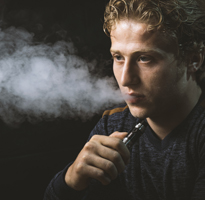No Smoking Allowed: How the FDA Fights Youth Smoking
October 1, 2017 The Food and Drug Administration (FDA) works particularly hard to prevent American youth from becoming addicted to nicotine products. Recently, the FDA took another big step to fight teen smoking rates by bringing all tobacco products – such as cigarettes, chewing tobacco and e-cigarettes – under its authority. With this new power, each state is now required to implement a minimum purchase age of 18-years-old to any consumer who wishes to buy tobacco products.
The Food and Drug Administration (FDA) works particularly hard to prevent American youth from becoming addicted to nicotine products. Recently, the FDA took another big step to fight teen smoking rates by bringing all tobacco products – such as cigarettes, chewing tobacco and e-cigarettes – under its authority. With this new power, each state is now required to implement a minimum purchase age of 18-years-old to any consumer who wishes to buy tobacco products.
Some retailers continue to profit off teens, which prove to be their most vulnerable consumers. It is important that we do not forget that the tobacco industry is a multi-billion-dollar industry. According to the World Health Organization (WHO), tobacco conglomerates prey on teenagers (13-18) and children (under 13) by developing effective marketing strategies to get them interested in smoking at early – and especially impressionable – ages. (https://www.who.int/tobacco/media/en/TobaccoExplained.pdf).
Researchers know that our brains continue to develop throughout our 20’s or possibly even 30’s. This means that during the adolescent years, a person’s prefrontal cortex – often known as the brain’s “remote control” because it regulates decision-making and impulse control – is still developing. Having underdeveloped prefrontal cortexes is what leaves teens more susceptible to making impulsive, irrational decisions – such as trying cigarettes.
The Centers for Disease Control and Prevention (CDC) reports that many as 70% of all adult smokers are interested in quitting smoking, yet it still causes an average of 480,000 preventable deaths each year. This means that tobacco products are the cause of every 1 out of 5 deaths. Nonsmoking bystanders can fall victim to other people’s deadly habit and do – 41,000 annual fatalities are the result of secondhand smoke, or smoke that is inhaled involuntarily from tobacco being used by others.
Smoking causes both short and long-term health consequences. We must do everything that we can to warn teenagers about the negative effects from smoking, as well as to implement prevention methods. The health consequences that smoking can inflict includes early heart disease, atherosclerosis, reduced physical fitness, reduced lung function and growth, coughing, stroke, decreased life expectancy, decreased memory and attention, shortness of breath, increased phlegm production, wheezing, bad breath, yellow teeth, skin wrinkling, and early skin damage.
According to the CDC, at least 3,200 teens under the age of 18 have already smoked at least one cigarette, and research shows that smoking one cigarette can sometimes quickly lead to becoming addicted. And, as many as 7% of middle school and 23% of all high school students currently use cigarettes, chewing tobacco or e-cigarettes. The Department of Health and Human Services (DHHS) estimates that at least 2,100 children ages 13-18 transition from occasional-to-daily smokers every day.
For all of these reasons, it is crucial that caregivers, parents, teachers and administrative bodies, like the FDA, continue to fight to lower the rate of teenage smoking. There are ways that you can help, such as reporting all potential tobacco product violations to the FDA directly. If you notice any of the following, you should consider filing a complaint:
- Sale of single (“loosie”) cigarettes;
- Sale of e-cigarettes, smokeless tobacco, hookah tobacco, cigars, pipe tobacco, cigarettes and all other tobacco products to minors;
- Sale of cigarettes, smokeless tobacco and cigarette tobacco through vending machines/self-service displays – except in adult-only facilities, and:
- Distribution of free samples of any/all tobacco products – except in adult-only facilities
To read the FDA’s complete list of tobacco sale violations, please click here. If you would like to file a complaint, you can click here. If the FDA finds the business to be in violation of federal regulations, the penalties may include the receipt of warning letters, civil money penalties or even a No-Tobacco-Sale Orders, prohibiting them from selling all tobacco products in the future.
Parents and caregivers can also start fighting the chances of teens smoking right at home, by teaching kids about the deadly consequences. The American Lung Association (ALA) urges parents to start talking to their children about the risks starting as young as 5-years-old and continuing to do so throughout high school. Here are a few of the ALA’s helpful and important tips:
- Be an example for your kid(s). If you are a smoker, try to quit. If you cannot or are unwilling to do so, please talk to them about how hard it is;
- Do not allow anyone to smoke inside – this can create new health problems as well as exacerbating preexisting ones;
- Discuss ways your teen can say no to their peers who may offer them cigarettes, and:
- Don’t threaten your teen if you find him or her smoking – instead, be supportive. Have a discussion about how the tobacco industry has exploited them to make them addicted and profit off of them. This can help promote a motivation to quit.
To read the full list of ALA tips for parents and caregivers to prevent teen smoking, please click here.
Philadelphia Personal Injury Lawyers at Galfand Berger, LLP Help Injured Victims Since 1947
If you have any questions or concerns regarding injuries arising from tobacco products, please contact our Philadelphia personal injury lawyers. With offices located in Philadelphia, Bethlehem, Lancaster, and Reading, Galfand Berger serves clients throughout Pennsylvania and New Jersey. To schedule a consultation, call us at 800-222-8792 or complete our online contact form.
 Google Screened
Google Screened
